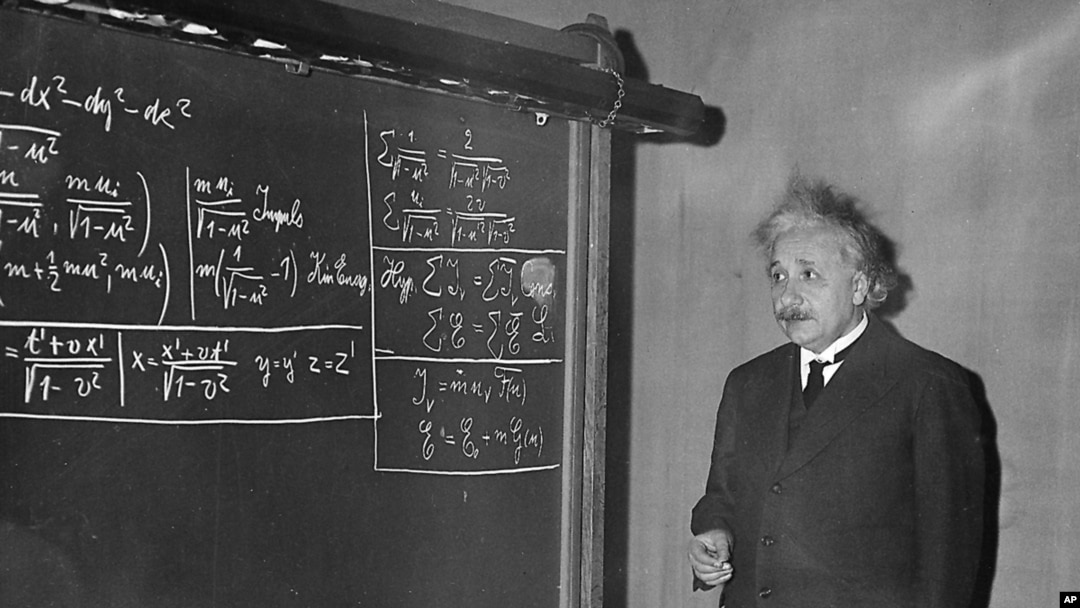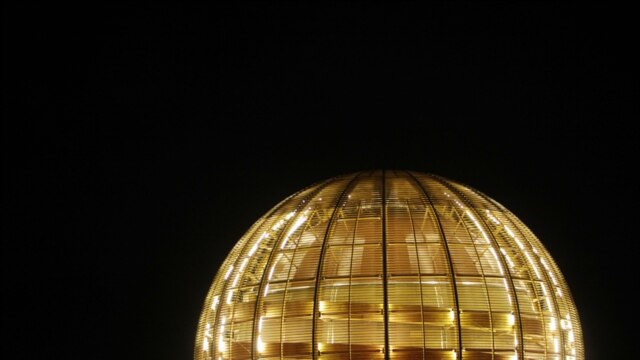Scientists at CERN, the Switzerland-based European Organization for Nuclear Research, say they think they have documented subatomic particles moving faster than the speed of light.
The implications of their findings are so revolutionary that the researchers say they cannot quite believe it themselves.
If confirmed, their work would prove that the basis of Albert Einstein's famous 1905 equation for the theory of relativity -- E=mc2 -- is wrong. According to Einstein's theory, there is nothing that can travel faster than the speed of light.
The findings from CERN has been met with skepticism among other physicists around the world. In fact, the researchers themselves say they are not ready to proclaim a discovery.
Instead, after three years of observations and data collecting, the researchers in Switzerland are asking other physicists around the world to try to independently verify their measurements of strange subatomic particles called "neutrinos."
CERN spokesman James Gillies told RFE/RL today that the "general consensus" among the world's physicists is that there must have been some fault in the design of the experiment, the equipment used, or the method of analyzing the data.
"This kind of thing happens quite often in science," Gillies says. "An experiment will measure something that looks unusual and the first thing you do there is say, 'We don't really believe this.' Then you try to understand it in terms of your experimental apparatus, your analysis, your techniques, and so on and so forth.
"Most of the time you do that and you find some rather mundane explanation and [the unexpected observation] goes away. But occasionally, you don't. That's what has happened in this case. The collaboration that has analyzed this data has tried very, very hard to understand it in terms of their apparatus and it hasn't gone away. So the next step is to put it up for scrutiny by the broader particle physics community, and that is actually what is happening right now."
Similar Results In 2007
Scientists at a competing research facility -- the Chicago-based Fermilab -- already have started looking at CERN's results. In fact, Fermilab researchers had found similar faster-than-light results in 2007 when studying neutrinos. But Fermilab's earlier work came with a large margin of error that raised doubts about whether the subatomic particles they studied had really gone faster than the supposed cosmic speed barrier of 299,792 kilometers per second.
In the latest CERN research, meanwhile, researchers from France and Italy fired a neutrino beam from a particle accelerator near Geneva to a laboratory 730 kilometers away in Italy. They found the neutrinos had traveled 60 billionths of a second faster than the speed of light, and they calculated that their margin of error was just 10 billionths of a second -- small enough to make the results scientifically significant.
Gillies says scientists spent months checking and rechecking their results to make sure there were no flaws in their experiment.
"Relativity has withstood the test of time for nearly a century, and it's not because people haven't been testing it. People have," Gillies says. "People have been measuring, doing experiments, and making observations about relativity for a very long time. And so far, nothing has shown that anything breaks this cosmic speed limit.
"So this would actually be at odds with quite a lot of what has gone before. That doesn't mean it is wrong. But there is a very strong feeling in the community that there must be a different explanation out there."
If the observations of the scientists at CERN are independently verified, Gillies says the work would have enormous implications for the future study of physics.
"One of the big dilemmas arising from 20th century physics is that so much of modern physics is based on two pillars that came up in the early part of the last century," he says. "One of them is relativity and the other is quantum mechanics. Relativity is a theory of gravity. There is no quantum theory of gravity. So trying to reconcile these two things is one of the really [most important goals] -- if not the most important goal -- for modern physics.
"If you start to find things like this, then maybe that would give you a way to reconcile the two basic pillars of modern physics. But first of all, we need to make sure whether this [observation] is real or not."
However, Gillies says it will be at least months -- and possibly several years -- before the results of independent research is completed.
The implications of their findings are so revolutionary that the researchers say they cannot quite believe it themselves.
If confirmed, their work would prove that the basis of Albert Einstein's famous 1905 equation for the theory of relativity -- E=mc2 -- is wrong. According to Einstein's theory, there is nothing that can travel faster than the speed of light.
The findings from CERN has been met with skepticism among other physicists around the world. In fact, the researchers themselves say they are not ready to proclaim a discovery.
Instead, after three years of observations and data collecting, the researchers in Switzerland are asking other physicists around the world to try to independently verify their measurements of strange subatomic particles called "neutrinos."
CERN spokesman James Gillies told RFE/RL today that the "general consensus" among the world's physicists is that there must have been some fault in the design of the experiment, the equipment used, or the method of analyzing the data.
"This kind of thing happens quite often in science," Gillies says. "An experiment will measure something that looks unusual and the first thing you do there is say, 'We don't really believe this.' Then you try to understand it in terms of your experimental apparatus, your analysis, your techniques, and so on and so forth.
"Most of the time you do that and you find some rather mundane explanation and [the unexpected observation] goes away. But occasionally, you don't. That's what has happened in this case. The collaboration that has analyzed this data has tried very, very hard to understand it in terms of their apparatus and it hasn't gone away. So the next step is to put it up for scrutiny by the broader particle physics community, and that is actually what is happening right now."
Similar Results In 2007
Scientists at a competing research facility -- the Chicago-based Fermilab -- already have started looking at CERN's results. In fact, Fermilab researchers had found similar faster-than-light results in 2007 when studying neutrinos. But Fermilab's earlier work came with a large margin of error that raised doubts about whether the subatomic particles they studied had really gone faster than the supposed cosmic speed barrier of 299,792 kilometers per second.
In the latest CERN research, meanwhile, researchers from France and Italy fired a neutrino beam from a particle accelerator near Geneva to a laboratory 730 kilometers away in Italy. They found the neutrinos had traveled 60 billionths of a second faster than the speed of light, and they calculated that their margin of error was just 10 billionths of a second -- small enough to make the results scientifically significant.
Gillies says scientists spent months checking and rechecking their results to make sure there were no flaws in their experiment.
"Relativity has withstood the test of time for nearly a century, and it's not because people haven't been testing it. People have," Gillies says. "People have been measuring, doing experiments, and making observations about relativity for a very long time. And so far, nothing has shown that anything breaks this cosmic speed limit.
"So this would actually be at odds with quite a lot of what has gone before. That doesn't mean it is wrong. But there is a very strong feeling in the community that there must be a different explanation out there."
If the observations of the scientists at CERN are independently verified, Gillies says the work would have enormous implications for the future study of physics.
"One of the big dilemmas arising from 20th century physics is that so much of modern physics is based on two pillars that came up in the early part of the last century," he says. "One of them is relativity and the other is quantum mechanics. Relativity is a theory of gravity. There is no quantum theory of gravity. So trying to reconcile these two things is one of the really [most important goals] -- if not the most important goal -- for modern physics.
"If you start to find things like this, then maybe that would give you a way to reconcile the two basic pillars of modern physics. But first of all, we need to make sure whether this [observation] is real or not."
However, Gillies says it will be at least months -- and possibly several years -- before the results of independent research is completed.



